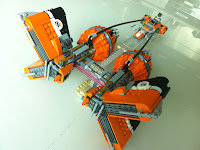Set ID: 7661 Jedi Starfighter with Hyperdrive Booster Ring
Number of Pieces: 575
Year of Release: 2007
Minifigs: 2
Purchased Price: About SGD104
This is one of the few sets that I bought from Australia when I was working there on ad-hoc assignments in 2008. For some reasons I cannot explain, some of the LEGO sets there were cheaper than that in Singapore. In line with some sales that took place then, the discounted price had made the lugging of this extra baggage much worthwhile.
The Jedi Starfighter had appeared in many sets before, albeit in different colours. This is the blue version driven by Obi Wan Kenobi for his mission to Utapau. As the name implies, the booster ring was designed to give the small Starfighter a "push" into hyperdrive as the mechanism was regarded as too large for the minute fuselage (that's strictly my opinion). Although circular in shape, the ring is able to hold the starfighter and stand erected steadily when you put it on display. The Starfighter itself does not score high in the look department, but together with the booster ring, this set now commands the vertical presence that many of the LEGO Star Wars sets lack.
The Starfighter can be mounted easily onto the horizontal stand that spans across the ring. A Y-shape funnel guides the Starfighter onto the stand smoothly as it flies in from behind the ring. Two diagonal bricks then rest on the wings of the Starfighter to complete the docking.
The Starfighter has a printed (praise the lord!) bubble cockpit to house Obi Wan. Instead of the now-common "staged" hinge, the cockpit can be opened at 90 degree using the loose hinge, i.e.you either keep it 90 degree open, or you close it. There is no in between. An golden brown (nice!) R4-G9 droid accompanies Obi Wan on his mission and resides on the left wing of the Starfighter. Although small, this Starfighter does come with nicely integrated undercarriage that will prove useful when you want to display the Starfighter alone with its wing extensions fully deployed.
Building Experience
Opening this set after half a decade was quite an exciting experience. Pouring everything on the floor, I immediately had a sense that this is definitely a "old" set. First, the unused stickers have already started to turn yellow (which explains why I did not use them during the construction), and then when I was looking at the packets of bricks, I realised that non of them are numbered! Ladies and gentlemen, welcome to the classic way of building LEGO!!! This is how it has been done in the past, pouring all the bricks out and sieving through them to look for the elusive brick that you want. It certainly is much more painful and time consuming but the fun and euphoria of doing brick treasure hunt is something that has diminished since the introduction of numbered packs. Upon closer examination, some of the blue coloured pegs had also de-coloured, almost making me believe there were two different colours in the same set. Given that this set has never been opened or exposed to elements, it does cast a doubt over the quality that I often rave about.
The spine of the booster ring is almost entirely made of technics parts. Building it needs many repetitive steps, many small bricks and much patience. Some steps do require fine motor skills which the younger kids may find challenging. There were many extra bricks left when the set was completed. Knowing that LEGO is seldom too generous with the extra bricks, I revisited all the steps to ascertain that I did not leave any bricks out. Well, I did not. So for once, LEGO's generosity prevails.
Minifigs
This set comes with two minifigs. One is the common Obi Wan Kenobi, and the other is Kit Fisto, another Jedi Master who has a tentacled head. Whilst LEGO uses mostly ABS plastics for almost everything, the head piece of Kit Fisto is one of the rare one that is made with rubber. This allows much of the details of the tentacles to be shown and perhaps keep the cost of producing the head piece low. Interestingly, Kit Fisto's light sabre in this this set has a matte handle, as compared to the more common silver one in the other sets.



























































